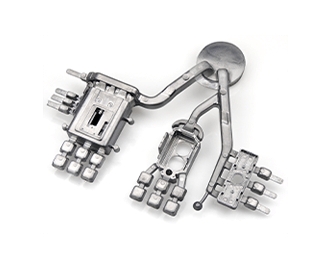When it comes to die casting, the material selection for your mold is a critical factor that can significantly impact the quality and efficiency of the process. In this article, we'll delve into the significance of material selection in die casting molds, exploring why it's a decision that should not be taken lightly.

Die casting is a popular manufacturing process used to create complex and precisely detailed metal components. Whether you are in the automotive, aerospace, or consumer electronics industry, the success of your die casting operation heavily depends on the choice of materials for your molds. Here's why it matters:
Die casting molds are subjected to extreme temperatures, as molten metal is injected into them. Choosing a material with high heat resistance is crucial to prevent deformation or premature wear and tear. Common materials for heat-resistant molds include H13 tool steel and steel alloys with specific heat-resistant properties.
The repeated injection of molten metal and the ejection of solidified parts can lead to abrasive wear. Material selection must consider the mold's ability to withstand wear over time. Steels like D2, A2, and M2 are known for their exceptional wear resistance.
Maintaining consistent temperature throughout the mold is essential for producing quality parts. A material with good thermal conductivity ensures even cooling, reducing the risk of defects in the cast parts. Copper and beryllium copper are often used for their excellent thermal conductivity.
Some die casting operations involve working with corrosive alloys or materials. In such cases, choosing a material that resists corrosion is vital to prolong the mold's lifespan. Stainless steel and nickel-based alloys are excellent choices for corrosion resistance.
Material selection also depends on the cost of the material and its machinability. Balancing quality with affordability is a key consideration in die casting mold production.
The choice of material for your die casting mold can directly affect your production efficiency. Opting for the right material ensures:
Fewer Mold Replacements: A high-quality, durable material can extend the life of your mold, reducing the frequency of replacements.
Reduced Downtime: Longer mold life means less downtime for mold maintenance or replacement, allowing for continuous production.
Consistency: Proper material selection contributes to consistent part quality, reducing rejects and rework.
Cost Savings: While high-quality materials may come at a higher initial cost, the long-term savings in reduced replacements and maintenance costs make them a cost-effective choice.

In summary, the careful selection of materials for die casting molds is a pivotal decision that can significantly impact the quality, efficiency, and cost-effectiveness of your manufacturing process. It influences product consistency, reduces downtime, and ultimately leads to long-term cost savings. Making informed choices in material selection is essential for the success of your die casting operations.
Huayin Precision: At Huayin Precision, we excel in the art of material selection for die casting molds, ensuring the highest quality and efficiency in your manufacturing processes. Contact us today to discover how our expertise can elevate your production capabilities.